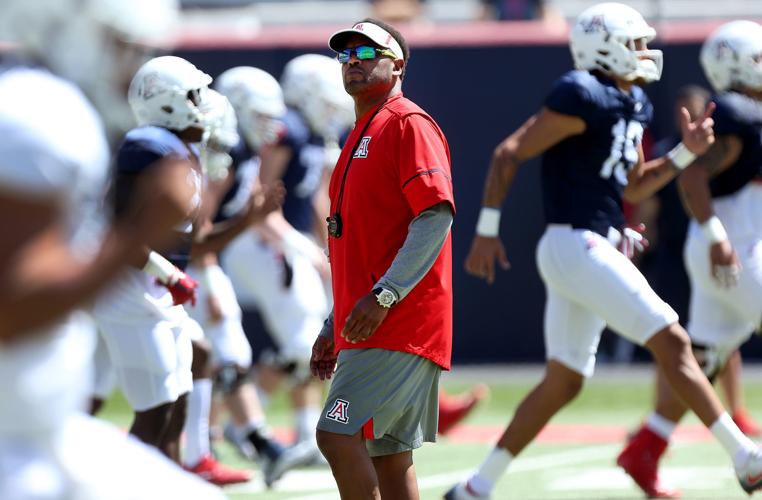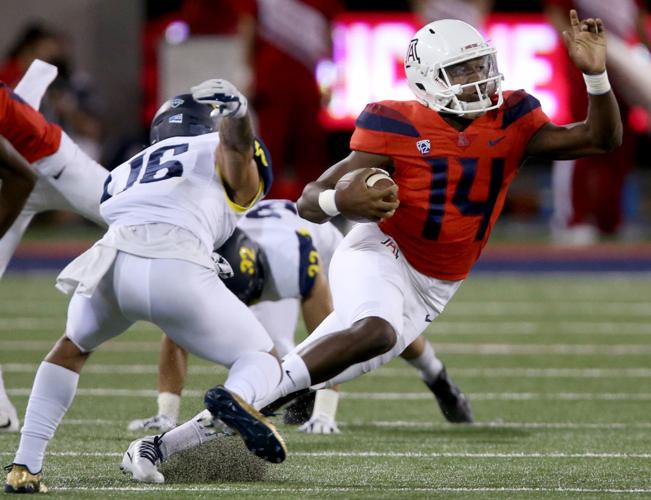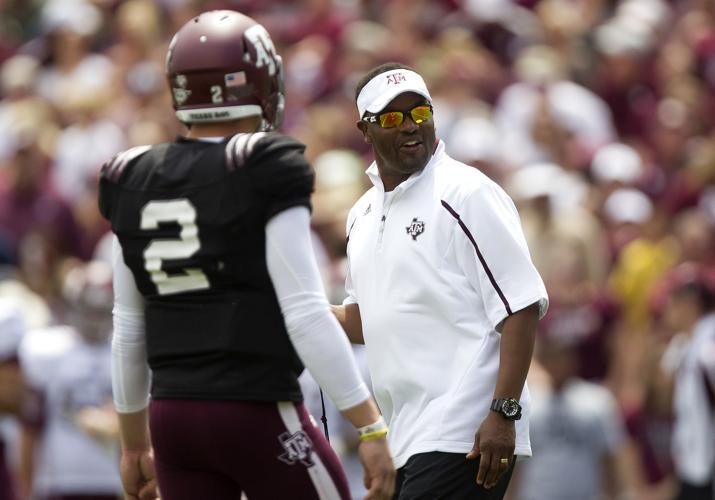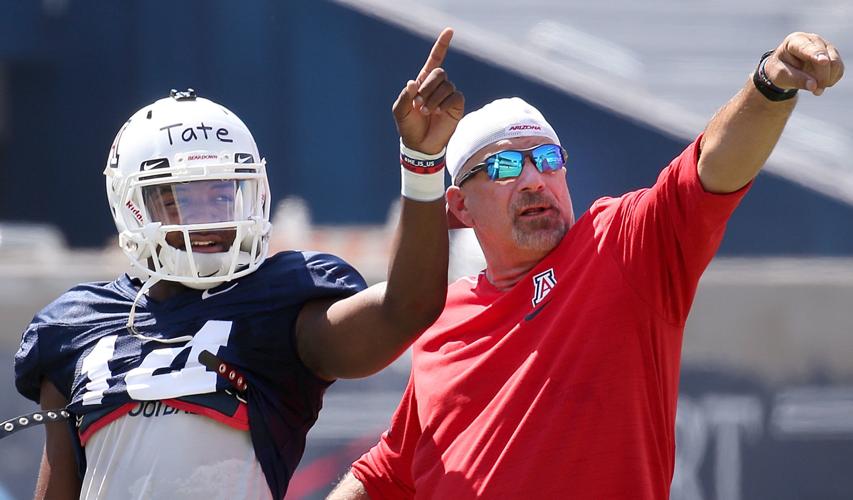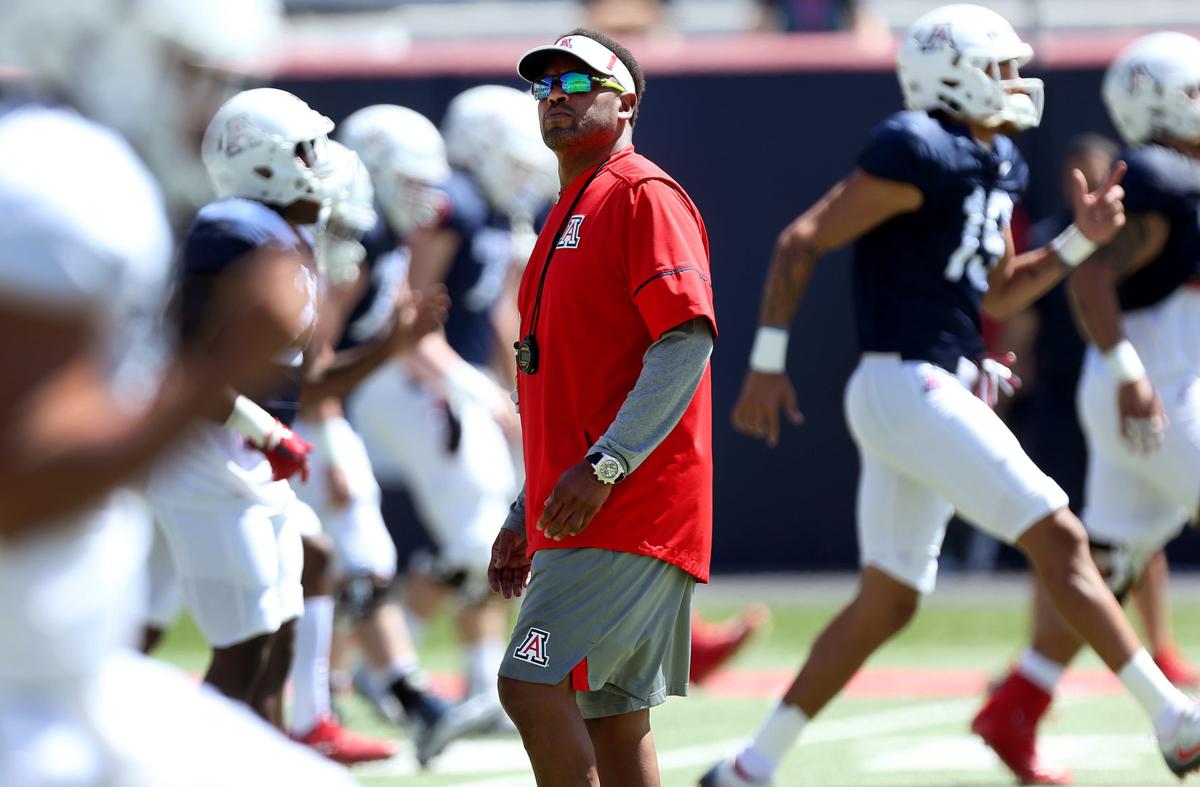Editor's note: This story appears in the Arizona Daily Star's 2018 college football preview, available for purchase Sunday.
No one is more important to the success of the 2018 Arizona Wildcats than the coach and the quarterback. No relationship is more important than the one between them.
Wherever he has been, quarterbacks have thrived under first-year UA coach Kevin Sumlin. The one he inherited here, Khalil Tate, is gushing with talent — much of it still untapped. Those two are the biggest names for the Wildcats — and the biggest reason many are bullish about Arizona’s chances this season.
Sumlin has been careful not to heap too much praise on Tate to avoid fueling the Heisman hype. But Tate can take comfort in knowing Sumlin has his back. No matter what transpires in their first season together, they’re in it together.
“He had a real calming presence with the quarterback,” recalled Texas Tech coach Kliff Kingsbury, who worked under Sumlin as a coordinator and quarterbacks coach at Houston and Texas A&M. “He wanted them to know it was their show. I never saw him yell at a quarterback one time.
“‘I’m behind you 100 percent.’ The players felt that. They weren’t looking over their shoulder.”

Arizona quarterback Khalil Tate (14) slices through the Northern Arizona defense in the third quarter of their game Sept. 2, 2017.
Sumlin didn’t play quarterback in college; he was a linebacker at Purdue. Aside from one year at Minnesota in 1997, he never directly coached quarterbacks as an assistant.
But Sumlin grew to understand that the relationship between the head coach and the quarterback is unique. He saw Drew Brees blossom under Joe Tiller, Sam Bradford under Bob Stoops. As the most prominent figures on their teams, they shared a common experience.
“It’s just different,” Sumlin said, “because the quarterback and the head coach get way too much credit when we win, and we get all the blame when we lose. You have to have that relationship. They don’t usually blame the right guard.”
Positive reinforcement
So how does Sumlin do it exactly? How did he help Case Keenum set NCAA records and Johnny Manziel win the Heisman Trophy?
Having been on offensive staffs that developed Brees and Bradford gave Sumlin “street cred,” Kingsbury said. But there was more to it than that.
“I just think it was the way he empowered that position,” said Kingsbury, himself a record-setting college quarterback. “He treated them like it’s your team, and you’re an extension of me. And there’s not going to be any sort of negativity.”
Several returning Wildcats have noted a different vibe within the program under Sumlin. His coaching style leans toward positive reinforcement. Sumlin “tries to pick up each player when something doesn’t go the way it’s supposed to,” third-year tailback J.J. Taylor said.
UA offensive coordinator and quarterbacks coach Noel Mazzone worked for Sumlin at Texas A&M and has known him for years. Mazzone alluded to “that good cop-bad cop deal” when asked about Sumlin’s involvement in the quarterbacks’ room. Mazzone wouldn’t say which coach plays which role, but it’s pretty clear who’s who. The opposite was true under Sumlin’s predecessor, Rich Rodriguez.
There’s more than one way to motivate a Wildcat. Rodriguez had plenty of success coaching quarterbacks, from Matt Scott in 2012 to Tate last year. Rodriguez just went about it in a different way.

Offensive coordinator/QB coach Noel Mazzone, right, is Arizona's highest-paid assistant coach with an annual salary of $600,000.
The most noticeable difference between Rodriguez and Sumlin is the manner in which they patrol the practice field. Where Rodriguez would scream, swear and stomp, Sumlin observes and oversees. As senior safety Demetrius Flannigan-Fowles pointed out, it’s not as if Sumlin can come onto the field and yell at players during a game.
Arizona State pitched Herm Edwards as a CEO. Sumlin exudes a similar corporate cool.
“What’s great about Coach Sumlin is, he’s going to let us assistant coaches do our jobs,” said special-teams coordinator Jeremy Springer, who also worked for Sumlin at A&M. “We’re an extension of him. What he says, we enforce.”
As it pertains to the quarterbacks specifically, Mazzone appreciates how Sumlin sees the big picture — “down and distance, field position, those types of things,” Mazzone said. “It makes my job a lot easier.”
Case, David and Johnny
Fun fact about Sumlin: He has had only one sub-.500 campaign as a head coach. That came in 2010, when Keenum and his backup suffered season-ending injuries in September. Sumlin had to start a true freshman, who performed well under the circumstances. We’ll have more on him shortly.
Keenum flourished under Sumlin, Kingsbury and Dana Holgorsen, who preceded him as offensive coordinator and quarterbacks coach. Keenum remains the all-time NCAA leader in passing yards and touchdowns.
Like Tate, Keenum already was on campus and had almost a full year of starting experience when Sumlin arrived. Keenum threw 14 touchdown passes as a redshirt freshman, the same number Tate had as a sophomore last year. The following year, his first under Sumlin, Keenum threw 44.
“It’s good to have a guy in the trenches with you that’s going to have your back, win, lose or draw,” Kingsbury said. “We had some tough times there at Houston. I didn’t see coach Sumlin waver.”
Keenum threw another 44 TD passes in 2009. In Week 3 the next year, Keenum suffered a season-ending knee injury. His backup, Cotton Turner, broke his collarbone in the same game.
Sumlin first turned to freshman Terrance Broadway. Then, after a bye week, he named another freshman, David Piland, the starter.
Although the Cougars would win only two of their final seven games, Piland passed for 2,641 yards and 24 touchdowns.
“He definitely instilled a massive amount of trust in me,” Piland said. “He was always supportive.
“I know he took a lot of heat for a lot of games I had early in my career because I was a freshman. He had enough faith in me to say, ‘Don’t stop doing what you’re doing.’”
Piland recalled the first time he threw an interception in a game. Sumlin waved him over. Piland figured the coach would ream him.
“He puts his arm around my shoulder,” Piland said. “He’s like, ‘What’s wrong?’ ‘I was just waiting for you to chew me out.’ He’s laughing. ‘No, keep slinging it. We’re all right.’
“I was coming over so wide-eyed. He was so supportive. I wanted to prove it to him, that I can get this done.”
Keenum returned the following season and threw 48 touchdown passes (with only five interceptions). Houston went 13-1, the best record in school history.
Sumlin did not coach the Cougars in the Ticket City Bowl, having taken the head coaches’ job at Texas A&M. In 2012, he would mentor another prolific quarterback, one unlike any other in the history of college football.

The run game was a big part of Johnny Manziel's Heisman season in 2012 under head coach Kevin Sumlin.
Manziel became the first redshirt freshman to win the Heisman Trophy. He was part-quarterback, part-rock star, complete with a nickname (“Johnny Football”) and a signature TD celebration (the money sign).
Coaching him presented an entirely new set of challenges. Texas A&M played on the biggest stage in the sport, having just joined the SEC. Additionally, social media was exploding and becoming mainstream.
“We’ve never seen anything like it,” said Kingsbury, who coached Manziel in 2012, “and we probably never will again.”
Sumlin did not allow freshmen to talk to the media. Although Manziel was a redshirt freshman, he did not speak until late November. Kingsbury believes that policy helped the young quarterback deal with his sudden fame.
“He was just able to focus on academics and do his thing,” Kingsbury said.
Sumlin has been similarly protective of Tate. The junior’s media exposure has been limited. He has talked to the Tucson press only twice since last season. He also was one of Arizona’s representatives at Pac-12 Media Day.
‘Taking ownership’
Despite Sumlin’s efforts to slow it down, the Tate hype train continues to roll. He has appeared on multiple magazine covers, including Sports Illustrated. He has made every list of college football’s best players. He’s prominent in the preseason discussion of Heisman Trophy candidates.
Whether it’s Sumlin’s influence, Tate’s humble upbringing or his unassuming nature, the star quarterback’s ego has not run amok.
“I think he’s handled it in typical Khalil Tate fashion,” UA athletic director Dave Heeke said. “He just has done it in a real professional, calm manner. I don’t think he’s trying to live in a world of fame.”
The word “professional” has been used to describe this older version of Tate (older being a relative term; he’s still just 19). Tate has used it himself. He already has been through a Manziel-like ascent, rocketing from obscurity to celebrity practically overnight. Tate knows what is expected of him, and he’s acting accordingly.
“I believe he’s putting more into the game,” senior receiver Shun Brown said, “taking ownership of his role as the leader of the offense and the team.”
“He’s changed a lot,” Taylor said. “He’s working hard, getting at it in the weight room. Becoming a quarterback — aka, a leader.”
Contrast that with Tate’s persona when he first arrived in Tucson in January 2016. He had turned 17 less than three months earlier. His older teammates thought of him as “that goofy little kid,” as senior tackle Layth Friekh put it.
Two-plus year later, Tate’s leadership skills have improved 100-fold, Friekh said. An example: Tate took it upon himself to watch more film this offseason. The coaches didn’t have to prod him.
Tate attended the Manning Passing Academy this summer. His biggest takeaway from meeting Peyton Manning?
“How serious he is,” Tate said. “How into the game he is. How much mental notes he takes.”
Mazzone can sense that Tate truly sees himself as a quarterback now. Maybe he always did, but now he’s putting in the work to prove it.
Whether the Sumlin-Tate partnership clicks remains to be seen. Sumlin doesn’t have a flawless record; the latter portion of his tenure at A&M was marred by the transfers of quarterbacks Kyle Allen and Kyler Murray, a pair of former five-star recruits.
But the success of Keenum and Manziel under Sumlin’s tutelage is undeniable. And he and Tate already are in lockstep about the quarterback’s accomplishments thus far. In a way, he’s just getting started.
“I like to tell people, I just got my foot in the door,” Tate said. “I haven’t done anything super-special.”


